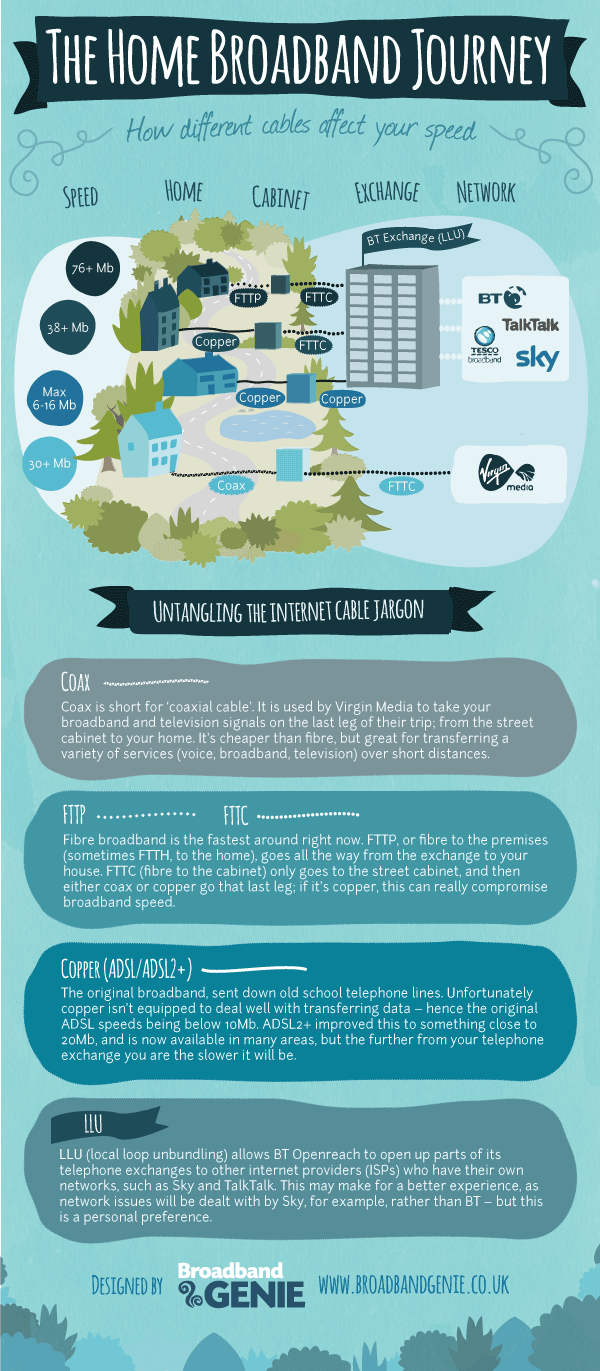Remember my earlier post about broadband? It’s a subject that a lot of people either don’t know about, or think they know about. I know, because in my previous job I was one of the guys on the end of the phone in a business ISP. The sheer amount of people calling up about broadband speeds was frightening, with some demanding that the “headline figure” (usually advertised some years ago as 24Mbps) should be delivered to them no matter what.
The truth is that the infrastructure (here in the UK at least) isn’t perfect, and investment tends to flow to the towns and cities with the higher populations, rather than out in the sticks where there’s less potential for a return on your investment. Getting out to those hard-to-reach areas costs more anyway.
Now there’s various types of broadband, and different companies have added some confusion by giving certain flavours a brand name. With BT it’s “Infinity”, and this name has become so prolific that other ISP’s get asked by their customers for the “Infinity” product, even though it actually applies to Fibre To The Cabinet, or FTTC.
Speeds vary wildly depending on your setup, distance from the exchange or “cabinet” and the product you’ve bought. ADSL and ADSL2+ products have now got more “realistic” speeds advertised, as have other products, and hopefully it’ll make our expectations and product selections more accurate. As an example, this broadbandgenie.co.uk infographic below does a great job of showing the differences in tech.
ADSL and ADSL2+ runs through copper and it goes either under the ground or across telegraph poles back to the exchange. Overlaid on your phone calls, you need a splitter or “microfilter” to filter out the voice and data side in your home, plus a router. The copper cables were originally dangled form those telegraph poles many, many years ago and you can’t really alter how far away your house is from the exchange, so your luck depends on proximity and line quality.
Fibre connections, at least those provided by BT, will travel from the exchange to those rather tall green boxes that you’ll see on footpaths and street corners. By using fibre optic connections they’re effectively moving the exchange into that green box, bringing it closer to your home. The remaining gap (with FTTC) from the green box to your home is bridged using standard copper cable. Nothing major needs to happen in your house other than a slightly new faceplate installation by a BT engineer and a VDSL modem / router needs to sit in your house. If you can get or afford FTTP (Fibre To The Premises) then the whole connection is via fibre and you’ll get very fast speeds indeed.
Virgin Media have their own infrastructure and roadside boxes. They’ve inherited a lot of this from many early cable operators, who dug up the footpaths up and down the country to lay down cabling a long while ago. If you’re lucky you’ll find a small cover in the pavement outside your house with “CCTV” printed on it. From this box, which covers the fibre optic cabling, Virgin Media will come and install a coax cable to make up the last few metres of the connection into your house. It’s a little bit like FTTC, but this time the green box is effectively buried in the pavement outside your home .. and you get TV too.

